What Does AI Say About Atlantic Yards?
It can be useful, but it can miss some things, or even make stuff up. A test of several questions posed to three models.
Artificial intelligence (AI), so we’re told, is the future of information, sucking up available reports, writings, and data to produce, in a flash, summaries and shortcuts—though perhaps with flaws, omissions, and even hallucinations.
So I decided to test various questions—about Atlantic Yards’ history, affordable housing, ownership, and more—on three services: ChatGPT, Gemini (from Google), and Claude.
Bottom line: all were somewhat to fairly useful, with Gemini (perhaps because I logged in?) the best, so I wouldn’t be surprised if students and others rely on AI (but, I hope, don’t stop there). That said, the Gemini-created image below—after I requested “ChatGPT vs. Gemini vs. Claude”—is a little… unsteady, which seems a metaphor.
None of the results were up to the minute, as they rely on a range of sources. Some had some serious hiccups. Curiously enough, when I retested ChatGPT, some of the hiccups went away.
My grades are between D+ and A- on various questions, but in some cases I may be too generous and in others too harsh. You may have different results, as well as different assessments. I suspect that the AI responses evolve.
A few observations
For a concise non-AI history of the project, see my May 8, 2024 article, Watch This Space, published by Urban Omnibus. Also see my very long FAQ and my recent article for City Limits, Brooklyn’s Stalled Atlantic Yards Plan Faces More Questions Than Answers.
Also see BrooklynSpeaks’ useful history.
To some degree, I could see my own writings, in my blog (but not this newsletter) and as a freelancer, reflected in the AI summaries.
However, I did not see the information reflected in the useful graphics below—thanks to my regular collaborator Ben Keel—in the AI responses, perhaps because the AI models don’t yet parse graphics.
It’s made me think. I have much more to report, some of which is based on documentation that only I have. How much of that will be sucked up by AI without credit?
The questions
Give me the history of Atlantic Yards?
What developers have been involved in Atlantic Yards?
Who are the owners of the Atlantic Yards residential towers?
Who have been the owners of the Barclays Center?
How much affordable housing has been built at Atlantic Yards and how affordable is it?
What’s the best source of information on Atlantic Yards?
Atlantic Yards history: ChatGPT
Word count: 821
Value: C
Flaws: No, Related Companies was not the successor company to Forest City Ratner.1 No, it’s wrong to say, “Several additional residential towers are under construction.”
Summary paragraph:
Atlantic Yards, now known as Pacific Park, represents one of New York City's most ambitious and controversial urban renewal projects. The development has reshaped a significant portion of Brooklyn, but not without criticism for its impact on the community and the pace of development. The Barclays Center stands as a symbol of this transformation, while the full vision of Atlantic Yards remains a work in progress, with ongoing development expected to unfold over several more years.
Notes: That’s not unreasonable, but it’s understandably bland.
Atlantic Yards history: Gemini
Word count: 694
Value: A-
Flaws: Well, it wasn’t a $6 billion plan initially. Some omissions are questionable.
Summary paragraph:
In summary, the history of Atlantic Yards/Pacific Park is marked by grand ambitions, significant community pushback, legal battles, economic headwinds, and a long and complex development process that has yet to reach its originally envisioned completion. While the Barclays Center has become a Brooklyn landmark and some housing has been added, the project's promises of extensive affordable housing, jobs, and open space have been significantly delayed and remain a subject of ongoing scrutiny.
Notes: This was reasonable, perhaps because it apparently relied in part on my own reporting, with details like the switch from Frank Gehry to Ellerbe Becket and SHoP and the name change to Pacific Park Brooklyn.
Atlantic Yards history: Claude
Word count: 410
Value: C+
Flaws: It’s wrong to say “the arena area retained the Atlantic Yards name” after Greenland USA took over. It’s way too vague to say “several buildings have been completed while others remain in various stages of planning and development.”
Summary paragraph:
Atlantic Yards (now known as Pacific Park Brooklyn) is a major mixed-use development project in Brooklyn, New York that has been shaped by controversy, economic changes, and shifting urban development priorities since its inception.
Notes: While a not unreasonable summary, this was too brief, lacking some key details.
Atlantic Yards developers: ChatGPT
Word count: 506
Value: C-
Flaws: No, Related Companies did not join the project. Nor did it partner with Related. Tishman Construction was a construction firm, not a developer.
Notes: Omitted were developers TF Cornerstone and The Brodsky Organization. No mention of Greenland facing default.
Atlantic Yards developers: Gemini
Word count: 381
Value: B-
Flaws: Related’s rumored entrance appears ahead of the roles of TF Cornerstone and Brodsky, which are not “developing” buildings but have already built them. It treats the Related joint venture as in process, rather than abandoned.
Notes: Empire State Development (aka ESD, previously ESDC) is presented in the list of developers, though it is (partly) correctly described as a state agency (actually: authority) that oversees the project. I'd say it “oversees/shepherds” the project.
Atlantic Yards developers: Claude
Word count: 276
Value: C
Flaws: No, the Kushner Companies didn’t express interest in acquiring the development.
Notes: No mention of Greenland facing default.
Atlantic Yards tower owners: ChatGPT
Word count: 401
Value: D-
Flaws: No, The Related Companies is not a prime owner. Brookfield Asset Management no longer has a consequential stake.
Notes: Omitted are developers and operators like TF Cornerstone, The Brodsky Organization, and Avanath, as well as Principal Global Investors.
Atlantic Yards tower owners: Gemini
Word count: 508
Value: B-
Flaws: No mention of Avanath. Claims that the joint venture with Related is ongoing. Doesn’t mention role of condo owners.
Notes: Gemini makes cautious statements, such as, “It's highly likely” that TF Cornerstone retains ownership of its buildings.
Atlantic Yards tower owners: Claude
Word count: 260
Value: D+
Flaws: Claims Greenland, not Avanath, owns 535 Carlton and 38 Sixth. Does mention condo ownership but claims 550 Vanderbilt “is one of the market-rate condo buildings,” rather than the only one. Claims 18 Sixth was developed by Greenland only, omitting Brodsky, while wrongly claiming 662 Pacific was a joint venture. Claims TF Cornerstone holds development rights for certain parcels.
Notes: At least it goes building by building.
Barclays Center owners: ChatGPT
Word count: 591
Value: D-/B-
Flaws: It claims that Related Companies and Greenland USA owned a stake in the arena. No mention of the role of Joe Tsai in BSE Global, much less the investment by the Koch family.
Notes: This seemed very off. I re-ran it this morning, and it was far more accurate, though it omitted the Koch investment and the fact that the arena is technically owned by the state.
Barclays Center owners: Gemini
Word count: 266
Value: B-
Flaws: The Koch family investment is omitted.
Notes: This accurately states that the arena is owned by the state and leased to Tsai, though it omits why: the fig leaf of state ownership allows for a tax-exempt site and tax-exempt financing.
Barclays Center owners: Claude
Word count: 213
Value: B-
Flaws: Wrongly claims that Mikhail Prokhorov increased ownership to 80% of the arena in 2015. The Koch family investment is omitted.
Notes: This accurately states that the arena is owned by the state and leased to Tsai “to enable certain tax benefits.”
Affordable housing: ChatGPT
Word count: 846
Value: C+
Flaws: It says the promise is 30% of the total, not 35%. It claims “about 1,000” units built, rather than 1,374. It underestimates the allowable rent levels keyed to Area Median Income. It doesn’t mention the lack of family-sized units or the May 2025 deadline.
Notes: It states, not unreasonably, “The process has been slowed by market conditions, financing challenges, and various political and legal obstacles.” It recognizes criticism for “the relatively high rent levels for some affordable units.”
Affordable housing: Gemini
Word count: 336
Value: A-
Flaws: It doesn’t explain why the affordable units have been skewed toward middle-income households. It doesn’t mention the lack of family-sized units.
Notes: It gets the numbers, the skew and the rising AMI correct, as well as the deviation from original promises. It mentions the May 2025 deadline. (Well, it relies in part of my coverage.)
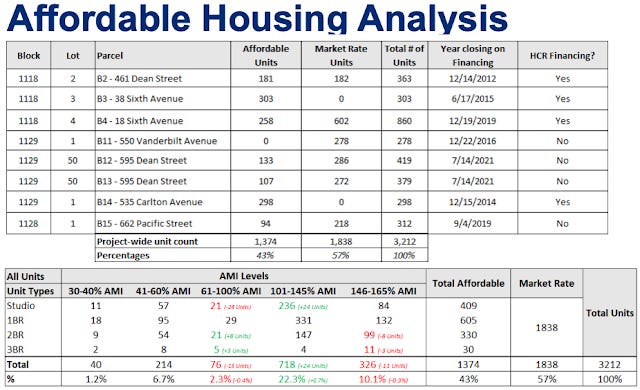
Affordable housing: Claude
Word count: 299
Value: D+
Flaws: It claims “approximately 800-900 affordable units” were completed as of late 2024, not 1.374. It goes building by building but misses 595 Dean (B12/B13). It claims the deadline has been extended to 2035.
Notes: It mentions a tilt to middle-income units but doesn’t specify why. It’s the only source to mention the lack of family-sized units.
Information source on AY: ChatGPT
Word count: 684
Value: D+
Flaws: The official project website is not the best source because, well, it’s been dead for a while. No, the New York Times, Brooklyn Paper, and Curbed are no longer good sources. Develop Don’t Destroy Brooklyn’s website is dead, too, while the coalition BrooklynSpeaks, yes, remains an important resource.
Unmentioned are The Real Deal, the real-estate publication that has covered the project most significantly in recent years, or City Limits, the policy publication to which I contribute.
Notes: No, the official Empire State Development site is not useful. Unmentioned: the ESD subsidiary Atlantic Yards Community Development Corporation (AY CDC).2 While the source mentions social media, my blog and this newsletter go unmentioned.
Information source: Gemini
Word count: 764
Value: A-
Flaws: The response offers additional general information about the project rather than drills down to other potential sources.
Notes: It cites the ESD and AY CDC, as well as BrooklynSpeaks, City Limits, The Real Deal, and my blog (but not this newsletter).
Information source: Claude
Word count: 175
Value: B-
Flaws: It misses the AY CDC and The Real Deal.
Notes: It says there’s no a single "best" source on Atlantic Yards/Pacific Park, but cites my blog, ESD, and even the local community boards. It states that Brooklyn Paper, Brownstoner, Gothamist, and City Limits have all provided significant coverage, without specifying the time frames.
When I asked ChatGPT the question again, it omitted the Related mistake.
I use AY CDC as shorthand, though it’s officially AYCDC.

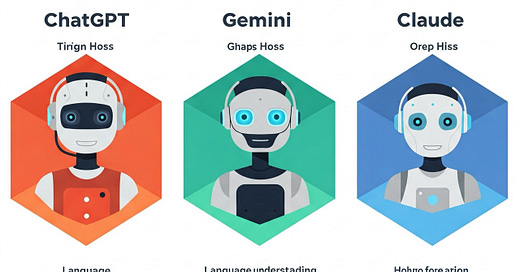



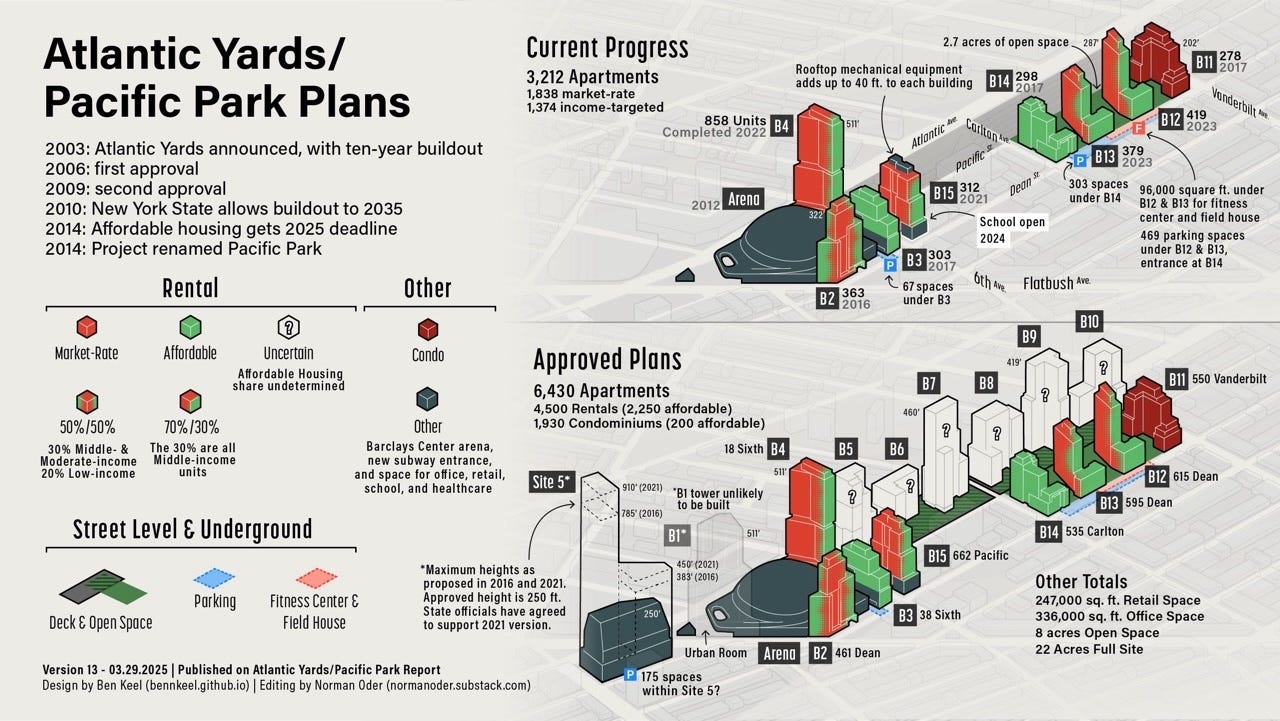

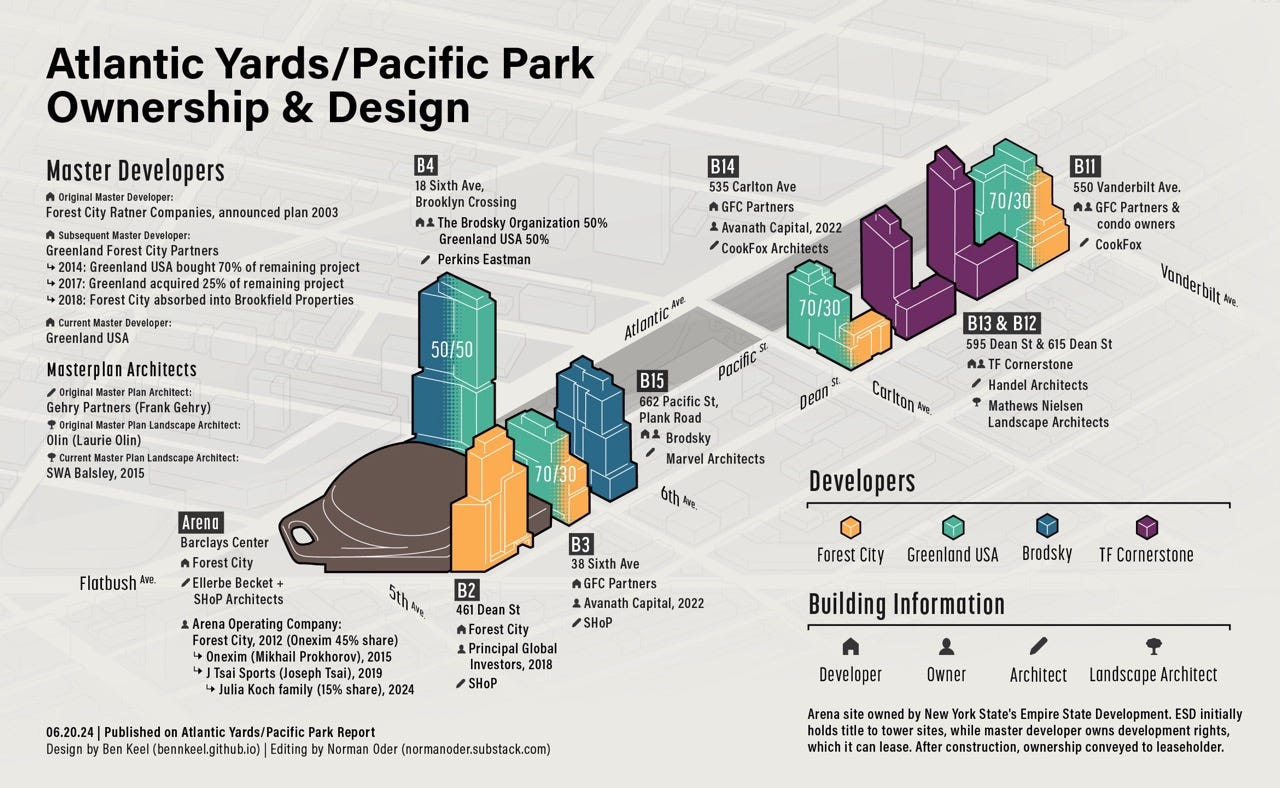
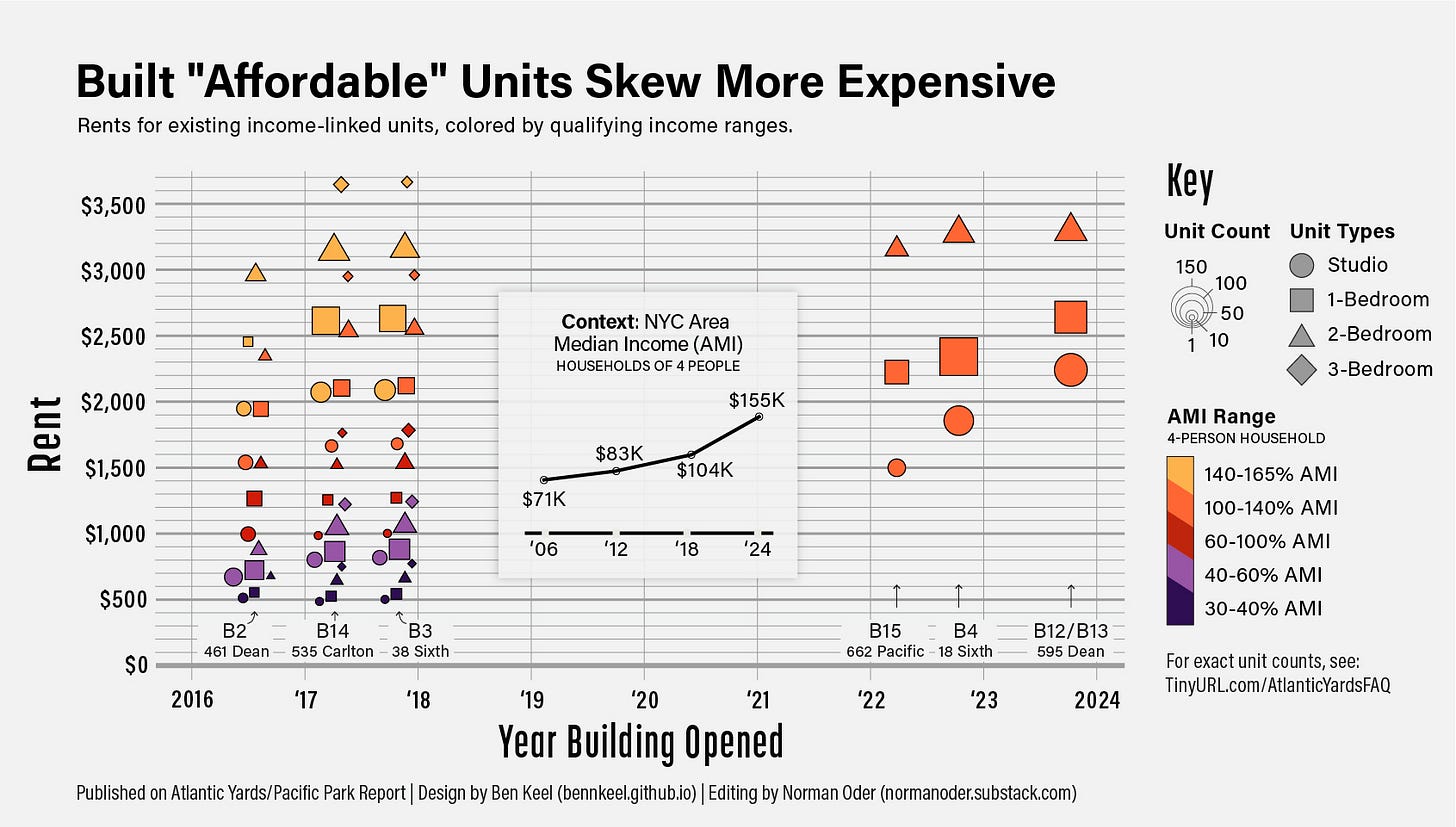
I gather from this that its flaws are within the laws of averages(averaging information) and so not very trustworthy for finding insights.